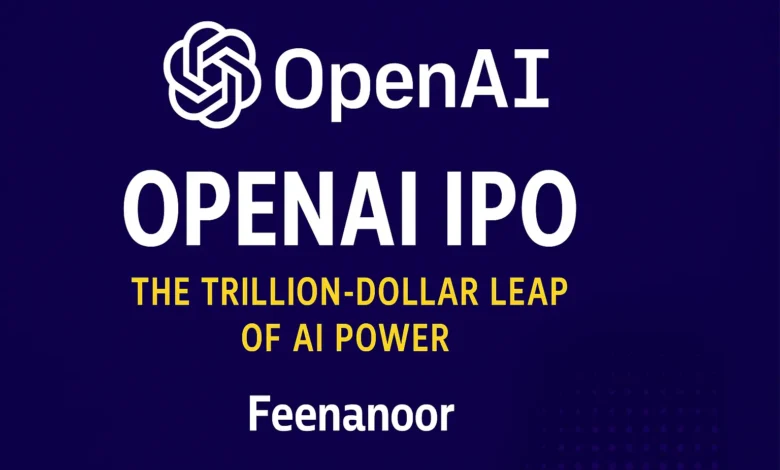OpenAI IPO: How a $1 Trillion Valuation Could Redefine the Future of Artificial Intelligence

OpenAI IPO marks the dawn of a new era where artificial intelligence transcends research and enters the realm of trillion-dollar global economics. Following its corporate restructure and the unveiling of its massive Stargate data-center project with Oracle, OpenAI is positioning itself not just as a technology pioneer — but as the future backbone of the AI-powered internet.
table of contents
OpenAI IPO: The Restructure That Changed Everything
In late October 2025, OpenAI announced a sweeping corporate transformation:
it would become a Public Benefit Corporation (PBC), preserving its nonprofit mission of advancing human-benefiting AI while enabling more flexible commercial operations. Microsoft, already OpenAI’s largest partner, solidified its position by increasing its ownership stake to 27 percent.
This restructure aligns OpenAI’s ethics with scalability. It allows the company to raise capital at the scale required for training frontier models like GPT-6 and GPT-7 while maintaining oversight by its nonprofit board.
In practice, OpenAI now functions under a “dual charter”:
- one arm focused on research transparency and safety,
- the other driving massive industrial growth through enterprise AI and cloud infrastructure.
Why the OpenAI IPO Could Reach $1 Trillion
According to Reuters, OpenAI has begun quietly laying the groundwork for an IPO valued between $800 billion and $1 trillion, potentially making it one of the largest public listings in history.
Here’s why that valuation isn’t as unrealistic as it sounds:
- AI Market Explosion: Global AI spending is projected to surpass $1.5 trillion by 2027.
- Revenue Streams: Subscriptions from ChatGPT Plus, API licenses, enterprise solutions, and partnerships with Microsoft Azure are scaling exponentially.
- First-Mover Advantage: OpenAI’s models define the standards competitors must follow.
- Infrastructure Expansion: The new Stargate initiative promises computing power that no private AI lab currently matches.
💬 Analyst View: If GPT-7 achieves autonomy levels expected in 2026, OpenAI could become the “NVIDIA of language models,” justifying its trillion-dollar target.
The Stargate Project: Building the World’s Largest AI Data Center
In partnership with Oracle and Related Digital, OpenAI plans to construct a 1-gigawatt data center in Michigan, the first of multiple “Stargate” sites worldwide.
This isn’t just an upgrade — it’s a revolution in how AI computes.
🔹 Key Highlights:
- Powered by renewable energy sources to reduce carbon impact.
- Designed for 8 GW of total capacity across future sites.
- Built to handle the next generation of AI models and multi-modal learning systems.
The goal is clear: create a global “AI backbone” to support real-time learning models, instant translation AI, and autonomous digital assistants. It’s a direct response to the limitations of current cloud infrastructure.
Microsoft’s Role: From Partner to Stakeholder
Microsoft’s 27 percent stake gives it a front-row seat in OpenAI’s next phase.
This goes beyond Azure hosting partnerships — Microsoft is essentially embedding OpenAI at the core of its business model.
Expect deeper integration into:
- Windows Copilot ecosystem.
- Office 365 AI extensions.
- Azure AI enterprise tooling.
💡 Effectively, OpenAI and Microsoft are now co-architects of the AI future — one building the brains, the other the infrastructure.
How the OpenAI IPO Will Reshape the Industry
The IPO isn’t just a financial event; it’s a shift in AI power dynamics.
- Investor Confidence in AI: A trillion-dollar valuation cements AI as the core of the next tech economy.
- Regulatory Tightening: Governments will scrutinize AI safety and transparency more than ever.
- Rise of AI Sovereignty: Countries may accelerate national AI projects to avoid total dependence on OpenAI.
- Acceleration of AI Hardware Markets: Chipmakers, cooling tech companies, and renewable energy providers will all benefit.
In other words, the OpenAI IPO is not just a Wall Street story — it’s a geopolitical and technological pivot.
Read Also : MyJio Google AI Pro Offer: Free ₹35,100 Gemini Access for Indian 5G Users
The Ethical Dimension
Critics argue that the move toward a for-profit structure might dilute OpenAI’s original mission of “benefiting humanity.”
Yet CEO Sam Altman insists the new structure balances profit with purpose:
“We need resources to build safe and powerful AI — our structure lets us do that without losing our soul.”
This balance between ethics and scale could become the template for future AI enterprises.
Global Implications
For the Middle East and Asia, the OpenAI IPO signals the beginning of a new digital competition wave.
Governments are already investing in AI sovereignty projects like Saudi Arabia’s “NEOM Cognition Initiative” and India’s “AI Mission 2030.”
OpenAI’s expansion is likely to inspire regional collaborations to develop localized models and training centers to stay competitive.
The OpenAI IPO is not just about valuation — it’s about vision.
It marks the moment when AI ceases to be a future concept and becomes a mainstream economic force.
From its ethical charter to its Stargate infrastructure and partnership with Microsoft, OpenAI is redefining what a technology company can be in the age of intelligence.
FAQ
1. What is the expected valuation for the OpenAI IPO?
Analysts estimate between $800 billion and $1 trillion based on growth and AI market projections.
2. When is the OpenAI IPO likely to happen?
Insiders expect it in late 2026, depending on regulatory approvals and market conditions.
3. What is the Stargate project?
A 1-GW AI data center network built with Oracle to power future AI models and cloud services.
4. Will Microsoft control OpenAI?
No, the company remains independent but Microsoft holds a strategic 27% stake.
5. How will this impact the AI industry?
It will set new standards for AI infrastructure, regulation, and global investment.
Discover more from Feenanoor
Subscribe to get the latest posts sent to your email.








